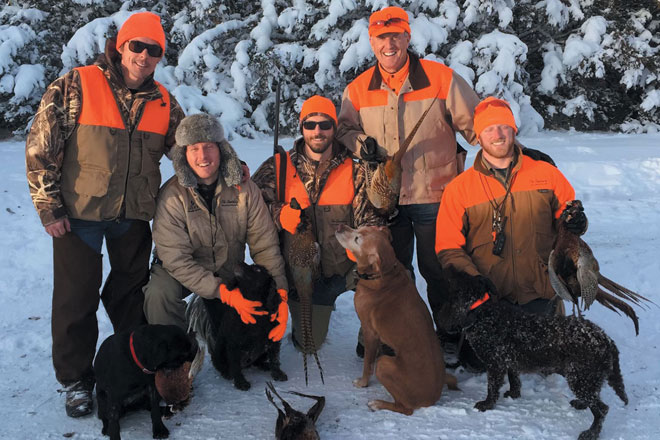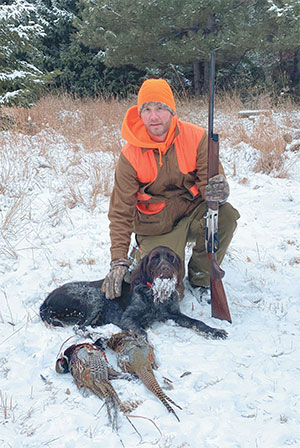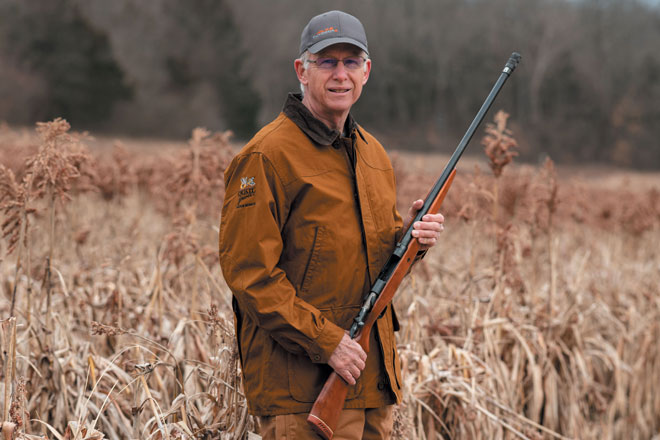By Andrew Johnson
Along with the call to experience the uplands comes the call to care for them. Here are three stories of extraordinary individuals who have helped lay the financial foundation of Pheasants Forever’s national comprehensive campaign, Call of the Uplands®.
Steve and Alli Garry
CONSERVATION DEFENDERS — $250,000-$500,000
For Steve Garry, answering the call has been simple.
“I’m maintaining the legacy my dad created,” explains the 66-year-old Garry, who grew up in Salem, South Dakota. “My dad was just a regular guy living in a small town in the Midwest, and the way we hunted was blue collar. No property. No dogs. It was just my dad and sometimes his friend, Bernie, and I can still remember the farm where we’d go out and just have a fantastic day.”
“As a result, my interest in and my knowledge of the outdoors came as a consequence of spending time with my siblings through a process my dad started many, many years ago,” Garry says. “I’ve simply continued that by taking my four boys hunting and connecting them to the tradition I was lucky enough to be given.”
 Steve Garry’s four sons — left to right Ryan, Nick, Travis and Mark — are Life Members of Pheasants Forever and are the primary drivers of Garry’s interest in preserving upland hunting opportunities. “Their future, and that of my grandkids, is my legacy,” he says.
Steve Garry’s four sons — left to right Ryan, Nick, Travis and Mark — are Life Members of Pheasants Forever and are the primary drivers of Garry’s interest in preserving upland hunting opportunities. “Their future, and that of my grandkids, is my legacy,” he says.
After high school, Garry studied business at the University of South Dakota in Vermillion, where he met his wife, Alli. He also went into the service and spent a couple years in the Army.
“I came out of the Army in 1978, and that’s when Alli and I moved to Sioux Falls, South Dakota. It’s also when I started our wealth management practice, Garry Private Wealth Resources, LLC,” he says. “We’ve called the Sioux Falls area home ever since, and we’ve felt very blessed to raise all four of our boys here.”
While Sioux Falls might be considered home base, each fall the epicenter of the Garry family’s life shifts about an hour and a half west down I-90 to a small farm about halfway between Plankinton and White Lake.
“I take an enormous amount of glee and pride in the fact that my boys and our grandkids love being at the farm, and I enjoy the time we get to spend as a family there,” he says. “But pheasant hunting is only one component of that experience. What we do as a family when we’re there goes way beyond just time spent hunting.”
It was at the farm where Garry says his affiliation with Pheasants Forever began, as his son, Mark, had two college friends who eventually went to work for The Habitat Organization.
“It was rather innocent, really. Through visiting with Mark’s pals and having them become part of our hunting traditions, we began to talk about what Pheasants Forever was all about and what it was trying to accomplish,” Garry recalls. “Through them the association grew, and we began looking for ways we could impact Pheasants Forever in a positive fashion. At the same time, we still wanted to recognize what we’re all about — what I’m all about as a person — is enhancing, protecting and carrying forward the tradition we were gifted.”
While Garry is a strong supporter of developing habitat publicly and privately, he’s quick to point to the bigger picture, saying he believes Pheasants Forever’s mission goes well beyond simply putting more grass on the ground.
“I’m on the steering committee for the Call of the Uplands® campaign. I enjoy that. But I’m just as interested in seeing what we can do collectively to enhance ever-improving habitat so that the wild things — the ducks, geese, turkeys, deer and so on — can thrive,” he states. “Because if the wild things thrive, the tradition thrives. If they go away, the tradition goes away. And we can’t let that happen. So, I invest.”
And to Garry, that’s what the Call of the Uplands campaign is all about — investing in and protecting the outdoor experience for the benefit of future generations.
“The Call of the Uplands lets you be a part of that effort,” he says. “It doesn’t demand you do so, but hopefully it reminds you what these traditions have meant to you and others. It’s up to you to embrace it or ignore it, and that’s the beauty of it.”
“It’s that subtle, quiet understanding of how right the preservation of habitat is to continuing the tradition that would be lost in the absence of an organization like Pheasants Forever,” he concludes. “You have to have a champion, and Pheasants Forever is our champion. I just get to tag along.”
Evan Carruthers
CONSERVATION ALLY — $100,000
Evan Carruthers supports Pheasants Forever for a few basic reasons.
For starters, he believes in PF’s mission to establish and improve habitat that yields tangible results.
Carruthers lives and works in the Twin Cities, but he owns and manages 2,500 acres in western Minnesota, close to where he grew up chasing deer, waterfowl and pheasants as a kid in the 1990s.
“Owning and managing land gives you a chance to see with your own eyes the impact of putting habitat on the ground,” he explains. “Most of my property is in wildlife habitat, and it’s become clear to me how resilient nature is and how wildlife responds to habitat.”

Evan Carruthers and his drahthaar Frannie after a hunt on one of his properties in Pope County, Minnesota.
Carruthers admits working on his property passed the hobby stage a long time ago, as it has evolved into a year-long passion he enjoys sharing with others.
“Habitat is something you can go out and touch, and I think that’s a big selling point for what Pheasants Forever is trying to do,” he says. “Raising money and putting it directly into habitat is a simple mission, and in my mind it’s a really effective one because it’s easy for people to see it work. There’s nothing better than proof, and I’ve had a lot of people hunt my ground who experience it every fall.”
Carruthers also firmly believes Pheasants Forever values the investment of time. And investing is something he knows a thing or two about. As a founding partner of Castlelake, a global equity firm headquartered in the Twin Cities, Carruthers speaks the investment language every day.
“Money is great, but its value has limits,” he asserts. “Donating time, in my experience, is significantly more valuable.”
And from a time perspective, Carruthers has grown to embrace paying his dues, serving on the Call of the Uplands steering committee and collaborating with PF staff and volunteers to host fundraising events in Minnesota that generate big-time dollars.
“I’ve been a Pheasants Forever member and gone to banquets for the last 15 to 20 years, but I’ve recently become a lot more active and have worked with Pheasants Forever to engage more people in the community,” he says. “The last couple years we’ve emphasized connecting people, particularly in the Twin Cities, with the organization who’ve never been exposed to it before. We’ve had some successful events that have had a positive impact. One event I helped host at Marsh Lake last year raised close to $100,000 in one afternoon.”
Finally, Carruthers believes PF’s multi-dimensional approach helps people understand why habitat matters for all wildlife, not just upland birds. In short, he credits Pheasants Forever for crafting its message to connect people with people, people to nature and nature to everything else.
“If you put a lot of prairie on the ground, sure it helps birds. But it also helps pollinators, it’s good for wetlands and waterfowl, it’s good for deer, it improves water quality — the list could go on,” he explains. “Today, I think Pheasants Forever is doing a great job of connecting those dots. PF lets people know its roots are definitely in upland conservation, but it also shows them how that will positively impact other things people care about.”
It’s a message that he’s also seen resonate with kids who have visited his property.
“I love introducing kids to the outdoors, and if you bring kids from the Twin Cities to western Minnesota in these big spaces driving ATVs or hunting, by the end of the weekend it’s usually one of the most positive experiences they’ve had,” says Carruthers, who has two kids of his own, ages five and three.
“I’m sure my kids will hunt someday,” he says. “But hunting is irrelevant. It’s more about exposing them to wild places and wild things. I want them to experience the outdoors the same way I did when I was growing up. Without quality habitat, that’s hard to do.”
Dennis Brune – ALPS Brands
CONSERVATION ALLY — $100,000
Like many kids who grew up in east-central Missouri, Dennis Brune’s youth was spent outdoors.
“We hunted rabbits and squirrels, but I had an uncle with a couple Brittanys. They would come out in the fall quite a bit. Back then when quail were so prevalent, if we would walk around my dad’s place and the neighbors’ farms we could jump three or four coveys,” says Brune, who lives about a mile as the crow flies from where he was raised on a 130-acre farm near New Haven, Missouri. “Man, for a teenage boy there’s nothing like working behind a dog, watching quail flush. That really got me going, and when you grow up hunting like that, it just kind of stays in your blood.”
 Dennis Brune holds his first gun, a 50-year-old Mossberg bolt-action 20-gauge that he used for small game and deer while growing up in Missouri.
Dennis Brune holds his first gun, a 50-year-old Mossberg bolt-action 20-gauge that he used for small game and deer while growing up in Missouri.
Brune’s love for the outdoors eventually led him to start ALPS Brands out of his home in 1993. Today, all three of his grown children work for the family business.
ALPS stands for Active Lifestyle Products and Services, and the original camping and backpacking brand is called ALPS Mountaineering. That brand’s success paved the runway for ALPS OutdoorZ to launch in 2007.
“When we started our outdoors brand, we decided it was important we gave back to conservation,” Brune says. “That was about the same time R3 started to gain traction, as well.”
The R3 movement — recruitment, retention and reactivation — aims to introduce people of every age, ethnic background and walk of life to outdoor activities and increase participation rates of current or lapsed outdoorsmen and women. It’s an effort Brune embraced, because in addition to losing grasslands, timber stands and other habitat, he recognized the outdoors had another problem on its hands: the downward trend of folks who were connected to the outdoors.
“Throwing money at a problem like that isn’t going to fix it,” Brune contends. “And, as our company grew, I came to the realization that up to that point our conservation efforts weren’t satisfying what I really wanted to do, which was connect more people with the outdoors.”
As a result, ALPS OutdoorZ redirected its conservation efforts by starting an initiative called Save the Lifestyle, which Brune says had a very small but specific goal in mind.
“I don’t think I’ve ever been around a youngster that’s been appropriately introduced to the outdoors that didn’t love it — you almost always bat a thousand,” he says. “So, with that frame of mind, we decided if could help start one new hunter each year, or even help save a hunter who has been away from it for a while, then that’s what we were going to do.”
ALPS OutdoorZ framed the initiative like a contest, where mentors could sign up, take a newbie hunting, and then share photos and some details of what happened for a chance to win a prize package.
“That first year we had about 250 people sign up, and if I’m being honest I was a bit embarrassed we didn’t have a better reach,” Brune admits. “I don’t know how word spread to Pheasants Forever about it, but one of their development guys contacted us, wondering about our mentor hunts. He said, ‘You had 250 the first time you did it? That’s amazing!’ And that’s where our partnership with Pheasants Forever started.”
Partnership is a word Brune doesn’t take lightly. In fact, he feels Pheasants Forever’s commitment to being a true partner is one way The Habitat Organization separates itself from the field.
“Without a doubt the thing that has helped our relationship grow pretty quickly is that Pheasants Forever and Quail Forever understand and value partnership,” Brune contends. “For them, it’s not about size of the check or when the next check is coming. They’re constantly asking how they can help, how they can we support what we want to achieve, and how we can keep working together.”
“The road we’ve gone down partnering with Pheasants Forever to expand this hunter-mentor program has been a real positive,” he concludes. “After working with quite a few other conservation organizations, it’s been unbelievably refreshing.”
Andrew Johnson reports and writes regularly for Pheasants Forever. He lives in Tea, South Dakota.
The Call of the Uplands is Pheasants Forever and Quail Forever’s first-ever comprehensive national campaign. This represents a $500 million effort designed to enhance over 9 million acres of upland habitat, permanently protect 75,000 acres through fee-title acquisition and conservation easements, and to cultivate the next generation of conservationists by providing over 1.5 million Americans with outdoor experiences from the West’s expansive landscapes and the vast Great Plains, to the quiet southern pine woods. This campaign is our best chance to bring together dedicated citizens, hunter-conservationists, farmers, ranchers, and other partners with a common cause: A promise to conserve our uplands before it's too late.
This story originally appeared in the 2021 Summer Issue of the Pheasants Forever Journal. If you enjoyed it and would like to be the first to read more great upland content like this, become a Pheasants Forever member today!